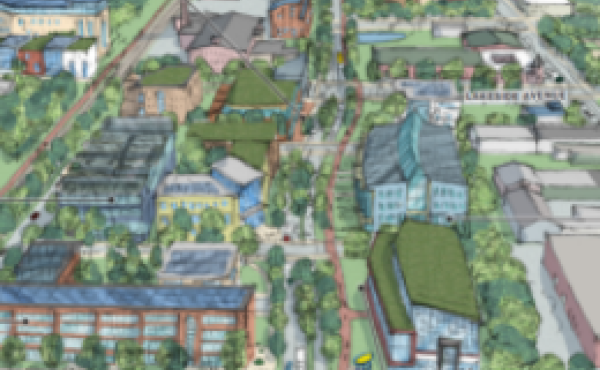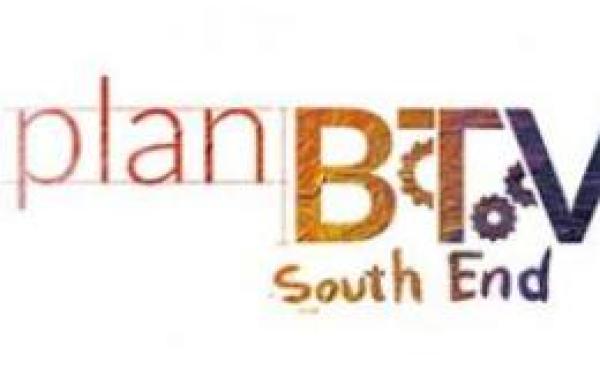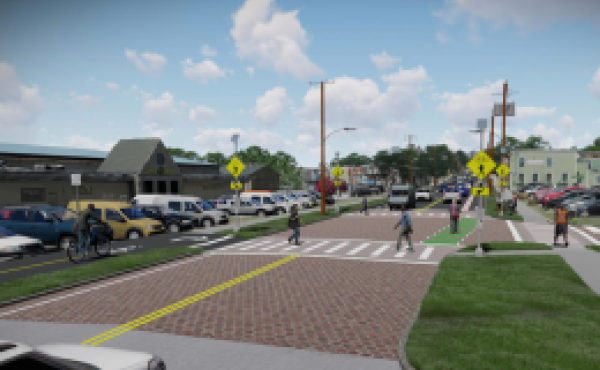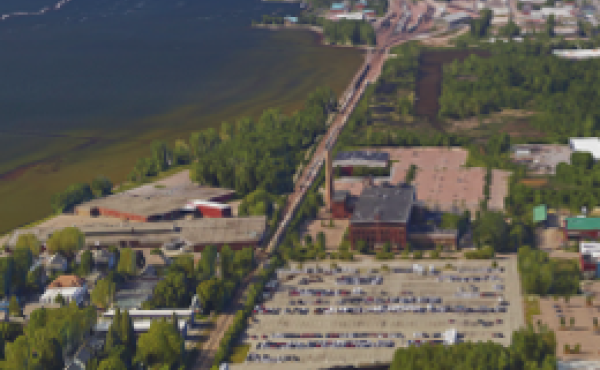Planning for a new neighborhood in the South End
Background
In January of 2023, the City entered into a Memorandum of Understanding (MOU) with the owners of land neighboring City-owned property in the South End that was recently rezoned to the South End Innovation Zoning Overlay District (SEID). The purpose of the MOU is to facilitate a conceptual design and development framework for the coordinated redevelopment of the parcels by applying the proposed regulations of SEID, resulting in a vibrant, sustainable, and accessible mixed-use neighborhood in the heart of the district. The MOU outlines a collaborative and efficient planning process for multiple independently owned sites, with the goal of informing a potential Development Agreement in the future. The City-owned parcel considered in the MOU is the undeveloped land at 68 Sears Lane. The other parties to the MOU, are Champlain College, the owner of 175 Lakeside Avenue, and Ride Your Bike, LLC, the owner of 125 Lakeside Avenue. (Ride Your Bike, LLC refers to the same developer as the nearby Hula Lakeside).
What makes this process unique?
The parties agree that a joint development framework enhances the properties’ true potential. In many ways, this is a project where the desired outcome is greater than the sum of its parts. In a traditional development where each property owner goes it alone, they create concepts, advance a proposal, and, through the permitting process, understand potential impacts to the community and its infrastructure. Concepts are refined and ultimately, the development proposal is permitted. In a growing area like the South End, this could mean disjointed plans and duplicative work. For example, if three property owners propose development independently, City water and transportation staff will have to analyze each project on its own, often without knowledge of how those other projects might impact the capacity of streets and pipes. This coordinated development avoids those inefficiencies in a few important ways:
-
The three large MOU parcels lack an internal street and pedestrian and bicycle path network. Pursuing development individually and independently could result in misaligned intersections, awkward dead-ends at property lines and an oversupply of parking. In coordinating a development framework, on the other hand, the Parties can plan creatively for a high-quality public realm that crosses property lines and helps people move across the future Champlain Parkway and throughout the South End safely and efficiently.
-
PlanBTV: South End envisions a South End where parking is shared and concentrated in a small number of facilities at the district’s edge. This vision is rooted in the belief that cars are necessary today, but that getting people out of their cars at the edges means the district’s internal streets and paths are as car-free as possible. Sharing in this work today is the best way to sharing parking tomorrow. Of course, some of us rely on cars for health or other mobility reasons. This work will find parking spaces within the development for those who truly need a car to move around the city.
-
The South End’s wastewater and stormwater infrastructure is near capacity. So we know that any growth, including the relatively dense type envisioned for the South End Innovation District, will require adding capacity to our pipes, but also finding space within the district to absorb more water. A focus of our coordinated planning is finding ways to implement large amounts of environmentally friendly green stormwater infrastructure. Rather than each MOU party analyzing its own water impacts, a coordinated development is how we can all remain responsible stewards for future generations and the health and quality of Lake Champlain.
-
Each of the MOU parties brings a unique perspective and vision for how they’d like to use their land. At the same time, we’ve learned that mixing uses is often the best way to create community and innovation. How can we create symbiotic relationships between Champlain College's students and faculty and the startup ecosystem that thrives at district hubs like HULA, Innovation Center and Generator? How can the City and Ride Your Bike, LLC create a mixed-income residential neighborhood of renters and owners? Can we think collaboratively to create spaces for artists and makers to work and live? These are the kinds of questions only collaborative planning can answer.
South End Coordinated Redevelopment Frequently Asked Questions
The Agreement identifies an agreed-upon set of foundational objectives and design goals for ongoing study and future collaboration over the next nine (9) months. Based on the outcome of this work, the City could enter into a Development Agreement by the end of 2024.
The Agreement will support the creation of:
- A site-wide housing plan, with a minimum of 20% affordable housing
- A public realm conceptual design
- A joint PUD application
- The study of the infrastructure challenges and opportunities on the site and the immediate vicinity, as well as potential funding mechanisms
See Mayor Weinberger's press release here.
While the coordinated redevelopment planning does not include the barge canal or adjacent sites, with investment from the State, other are proposing and planning new developments including the proposed project at 453 Pine Street. Those developments, along with the coordinated redevelopment sites, will contribute to the success of the South End Innovation District.
Explore Related Topics

South End Innovation District

PlanBTV South End

The Champlain Parkway


